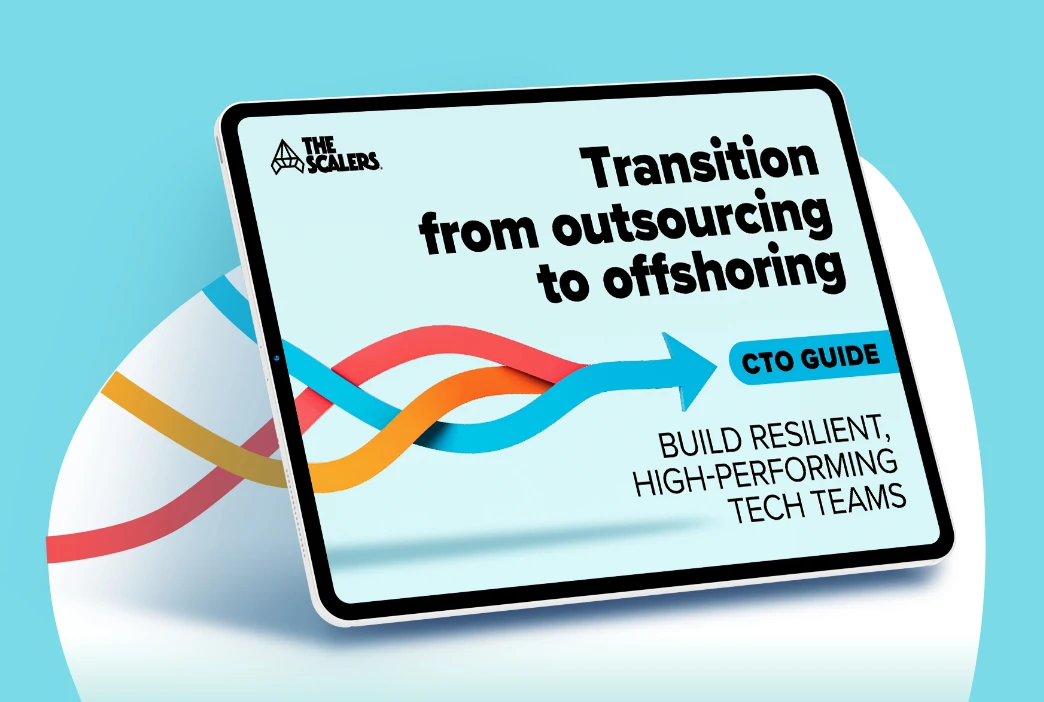So you’re thinking of extending your development team. You’re not alone: we surveyed 100 CTOs and found out that 76% of them are either already offshoring or planning to.
But unfortunately, not every extended development team project is successful. Many CTOs fall into common traps that slow progress, run projects over budget, and suck up precious time.
To ensure you don’t get derailed by these same missteps, we’ve prepared this expert playbook. It includes best practices, plus common errors and actionable tips to help you avoid them.
If you follow the advice laid out here, you’ll be guaranteed to get a development team that helps and not hinders your roadmap.
But first, let’s make sure we’re on the same page about what an extended development team is in the first place.
What is an extended development team (and how does it differ from a dedicated, augmented, and outsourced team)?
The extended team model is a way to scale development operations by adding additional team members in another location, typically abroad. It’s sometimes confused with staff augmentation, but while staff augmentation can be for one developer, by definition an extended team has multiple members.
Extended teams are typically hired by a third-party offshoring partner who recruits talent, sets teams up with a place and the hardware they need to work, and handles all other operations on the ground, like payroll and HR.
It’s most common for team extensions to be a longer-term solution to offer continual support to an at-home development team. For short-term or project-based work, the staff augmentation or outsourcing models are typically the better choice.
Here’s a quick breakdown of each model to help align your strategy to your needs and roadmap:

Mid-to-long term offshore development
- Dedicated team: A complete offshore development team hired by a third party, made up of full-time employees who work exactly the same as your in-house devs do.
- Team extension: Multiple team members provided by a third party to scale an in-house development team, typically on an ongoing basis.
Short-term and project-based offshore development
- Staff augmentation: Hiring additional talent from a third-party provider to fill short-term skills gaps in an in-house team; can be as little as one team member.
- Outsourcing: Contracting external talent from an outsourcing provider. Devs are typically assigned to your projects from a “bench” of available talent. They are external to your company and move on when the project is done.
When to choose an extended team: Common decision triggers
So when should you set up an extended team? From our experience, these are some key signs that building a software team extension is a good option to consider:
- Your development goals outstrip your budget.
- You need specific development skills that you can’t find locally.
- You can’t hire enough quality developers locally.
- You need to scale your development operations to get ahead of the competition.
If any of these statements apply to you, hiring extended team members with the right model will help.
The exact benefits you can expect depend on the specifics of the model you adopt. There are, however, some general advantages you can count on, including access to niche skills and lower overheads when going offshore in talent-rich hotspots.
When approached the right way, these benefits provide strategic advantages for IT leaders to hit development deadlines, optimise their tech budgets, and cover short and long-term skills gaps.
How to implement an extended team: From decision to first release blueprint
Considering the scenarios above (and the horror stories you may have heard from your colleagues that tried and failed to go offshore), what’s the best way to build an extended development team that lasts?
Based on our experience building more than 130 of them, we’ve established a proven, step-by-step playbook that avoids common pitfalls. This approach has provided value-adding team extensions for businesses whose previous efforts failed, as well as those going offshore for the first time.
Here are the key steps:
- Identify your needs and goals: What roles are you looking for? Where are the bottlenecks in hiring and development? What does your roadmap look like and how can an extended team accelerate it? How many development cycles worth of work do you have for your team extension?
- Identify the right extension approach for your business: Are you looking for a short-term project or a long-term product approach? Do you want to hand over project management to a third party or keep it in-house? Don’t take this part lightly. Picking the right model at the beginning is the most crucial factor to offshore success.
- Draw up a list of possible locations: Gather a selection of partners in different locations to ensure you make the right choice. For example, a UK-based business could consider Eastern Europe countries such as Poland, Romania, and Ukraine for nearshoring options and more time zone overlap at a higher overall cost, or more distant locations like India or the Philippines for a lower overall cost but fewer overlapping hours. US companies on the other hand often offshore to distant locations to gain extended coverage, as their offshore teams continue working while they sleep. In general, compare locations based on talent pool quality and depth, costs, and overlap in working hours.
- Vet possible partners thoroughly: Don’t settle for the first partner you find. Be sure to weigh fully-loaded costs, including taxes and other fees, not just developer salaries, in each offshore location to get a better idea of the total cost to your company. Check their models, certifications, and case studies, paying special attention to their approach to IT security, compliance, and IP protection. Ask them challenging questions and notice their approach to communication; this will show you how they’re bound to operate in the future.
- Make an informed decision: Go back to your original assessment and check how each partner holds up. Stay alert to red flags like hidden costs and excessively low salary rates.
- Integrate your team extension fully: This will be far easier with a high-quality partner who not only finds suitable employees but also makes sure they are onboarded into your systems and workflows, and who supports a work culture that keeps them engaged daily.
If you want more details, check out this ultimate (free!) guide on how to build an offshore team that actually works.
Extended development teams: 4 costly mistakes and how experts avoid them
With that all out of the way, let’s make sure you are ready to avoid the most common extended development team mistakes.
While there are a few risks companies can fall into once they decide to extend their IT teams, some are more common and costly than others.
After more than 10 years of building tech teams for companies based all over the world, the following four are the most common mistakes partners have made before they get offshoring right.

Mistake #1: Outsourcing your development processes
If you want to extend your existing development team, it’s crucial to look beyond a temporary arrangement that can work for a one-off project.
Building an extended team is a permanent solution, and the engineers that you hire become genuine employees of your business.
When working with an outsourcing vendor, you get access to engineers who don’t work for you exclusively, but rather for the outsourcing company. In other words, they are NOT your employees, which means that they aren’t fully invested in your business.
Often, they’re working on multiple projects for multiple clients at the same time. With little to no focus on your business, more often than not, you’re left with delays, substandard software, no team, and no internal knowledge of the work. Again, while this is typically not a problem for project-based work, it’s not the right strategy for businesses looking for a real product team.
An extended software team, on the other hand, is yours, in every sense of the word. They work for you, they believe in the vision of your business, and their goal is simple: to help you grow your business by building software.
If your core business is software development, then it should stay within your organisation and not in the hands of an outsourcing vendor that you don’t have control over.
Sure, outsourcing might seem like a simpler and cheaper option, but it won’t give you the long-term collaboration crucial for building great software.
Mistake #2: Evaluating cost rather than value
“How much will this cost?” is a key factor for any business in every decision. As it should be.
While cost is a glass ceiling that somehow can never be breached, fixating too much on price can mean that you’re not looking at the value proposition of the deal.
The result?
Many businesses, when given a choice, will choose the less expensive option.
Not surprisingly, this is usually the wrong choice because lower rates don’t always mean getting the better end of the bargain.
Lower costs almost inevitably translate to lower quality. Not to mention hidden fees that can end up spiralling out of control.

Focus on value for the cost-optimal solution.
Keep the price aside for a moment, and focus on asking a bigger question: what value can they bring to the table?
Assess potential development partners’ portfolios, their expertise, and cost effectiveness. More often than not, higher rates bring about better results in the long term as more experience usually translates to greater productivity and success rates, plus other advantages, like having strategies in place to foster cultural alignment between teams.
If the facts and figures laid out don’t speak for themselves, then you’re better off not making that deal.
Mistake #3: Not involving your extended team members enough
Creating developer silos is one of the biggest mistakes CTOs can make when transitioning from local to distributed teams.
When you have a software team extension, it’s important to remember that they’re as much a part of your organisation as your local team is. The only real difference is that they sit in a different office space.
Depriving your remote team of important business knowledge, keeping them away from team calls, or not letting them voice their opinion or feedback can lead to them feeling isolated, unappreciated, and unrecognised.
Your extended team will not have a comprehensive view of the business, the project at hand, and your larger business goals, which will result in unoptimised software solutions. In turn, this can affect their morale and motivation, and hinder productivity.
So what can you do?
A study conducted by Harvard Business School showed employees who were recognised and appreciated by their superiors were more than 40% more engaged than those who weren’t.
It’s that simple. Make sure to include your extended team in any important discussions, ask them for ideas, brainstorm together, appreciate their efforts, and collaborate on day-to-day tasks.
Treat your extended team no differently than your at-home team, and see the magic happen.
Mistake #4: Not establishing a clear roadmap
Imagine building a stellar extended development team, all ready to work on building software, but you’re not able to assign the right tasks to them because you didn’t plan well in advance. Sounds like trouble, right?
An integral part of collaborating with an offshore provider and building a remote team is planning.
Before you even partner with an offshore development company, it’s essential to put together a clear roadmap with a set of actionable steps for the near future. Rushing into a collaboration headlong and building requirements on the fly will lead to chaos and confusion, rather than increased productivity.
Make sure that you have enough work for your remote team for the next one to two development cycles, at the very least.
We typically advise partners to start planning well before their first hire has even been onboarded, and no later than 30 days in advance of their first day.
Assigning ownership: How Johnson Health Tech accelerated delivery with an extended team
Johnson Health Tech, a global leader in manufacturing commercial and residential fitness equipment, had an existing network of freelancers across the US.
The talent was there, but the model wasn’t right.
What they really needed was one central location where their own in-house engineers could test software features on real hardware, unlocking insights into the product and gaining a true understanding of their users.
Setting up an extended team allowed them to achieve that.
Johnson Health Tech started out building a three-person team extension, which was initially planned to help bridge development between existing teams. Soon, the team became the core of their R&D efforts, and in 2025 is currently sitting at nine engineers.
By going offshore with an in-house team rather than relying on contracted talent, Johnson Health Tech is now able to deliver twice as fast as before, an outcome that was only possible thanks to their engineers’ deep understanding of the company.
Conclusion
When done right, expanding your development team is the most cost-effective way to accelerate your product delivery and overcome talent shortages. When done incorrectly by making the extended development team mistakes above, it becomes an expensive hindrance to your development goals.
Make sure you pick the right path.
FAQs
Staff augmentation is the better choice when you are looking to fill short-term talent gaps while bringing on fully integrated talent. This is a good option for businesses that see a sudden spike in demand, or need to finish a particular piece of work, but want to keep project management and permissions in-house rather than outsourcing.
You should use the same retention strategies that you use for your current at-home team, including learning and development opportunities, a competitive salary and benefits package, recognition and integration, well-being initiatives, and flexible working arrangements that support work-life balance.
Startups should consider building an extended team when they are unable to find the talent they need locally, or the cost to hire locally has become prohibitive.
This will largely depend on the quality of your onboarding processes for remote team members, your team’s ability to align meeting times and standups with remote colleagues, the maturity of your offshore development partner’s security protocols, and their ability to find high quality talent abroad that have all of the hard and soft skills you are looking for. Make sure to look for an offshore development partner that has a proven track record of building high performing, secure global teams.
Remote collaboration and communication tools like Slack, Asana, Notion, ClickUp, and Google and Microsoft workspaces can keep distributed teams on the same page. If you already have remote or hybrid team members working from home, you can use the same tools with your extended team.
| Want help building an extended software development team in India? At The Scalers, we’ve set up over 130 tech teams for organisations like Johnson Health Tech with our proven team extension solutions. If you’re interested in exploring how offshoring with us can help you expand your team with top software engineers, send us a message. Our experts will analyse your exact needs and help you build a world-class team! |
Build Your Team,
Not Just a Contract
With The Scalers’ offshore dedicated development team, you get engineers who join your workflow for the long run. Grow steadily, stay flexible, and work with people who care about the product as much as you do.








